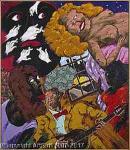Robert H Colescott
Robert H Colescott
Place: Oakland
Born: 1925
Death: 2009
Biography:
Robert H. Colescott was an American painter. He is known for satirical genre and crowd subjects, often conveying his exuberant, comical, or bitter reflections on being African American. He studied with Fernand Léger in Paris. According to Askart.com and Artcyclopedia.com, Colescott's work is in many major public collections, including (in addition to the Albright-Knox) those of the Museum of Modern Art in New York, the Corcoran Gallery of Art, the San Francisco Museum of Modern Art, the Museum of Fine Arts, Boston, the Hirshhorn Museum and Sculpture Garden, and the Baltimore Museum of Art.
Colescott developed a deep love of music early on. His mother was a pianist and his father was an accomplished classical and jazz violinist. They moved from New Orleans to Oakland, California, where Colescott was born in 1925. He took up drumming at an early age and seriously considered pursuing a career as a musician before settling instead on art. The sculptor Sargent Claude Johnson was a family friend who was a role model to Colescott growing up, and was also a connection to the Harlem Renaissance and artwork dealing with African-American experience. In 1940, Colescott watched as the Mexican muralist Diego Rivera painted a mural at the Golden Gate International Exposition on Treasure Island near San Francisco. Colescott went on to absorb the Western art historical canon and to explore the art of Africa and New Guinea. He would always be acutely aware what was going on in the contemporary art world. Nonetheless, these early experiences remained touchstones.
As a budding artist, Colescott was drafted into the U.S. Army in 1942 and served in Europe until the end of World War II. His tour of duty took him to Paris, then the capital of the art world and a city that was hospitable to African American artists. Back home, he enrolled at UC Berkeley, which granted him a bachelor's degree in drawing and painting in 1949. He spent the following year in Paris, studying with French artist Fernand Léger, then returned to UC Berkeley, earning a master's degree in 1952.
Like many artists of his generation, Colescott maintained parallel careers as a committed and influential educator and painter. He moved to the Pacific Northwest after graduation from UC Berkeley and began teaching at Portland State University. He was on staff there from 1957 to 1966. In 1964 he took a sabbatical with a study grant from the American Research Center in Cairo, Egypt. He returned to Portland for a year but went back to Egypt as a visiting professor at the American University of Cairo from 1966 to 1967. When war broke out, he and his family (then-wife Sally Dennett and their son Dennett Colescott, born in Portland, Oregon in 1963) moved to Paris for three years. They returned to California in 1970 and he spent the next 15 years painting and teaching art at Cal State, Stanislaus, UC Berkeley and the San Francisco Art Institute. Colescott accepted a position as a visiting professor at the University of Arizona in Tucson in 1983, and joined the faculty in 1985. In 1990 he became the first art department faculty member to be honored with the title of Regents' Professor.
It was in Portland that Colescott's professional career as an artist was firmly established, thanks in large part to patron of the arts and philanthropist Arlene Schnitzer, owner and director of the Fountain Gallery, which she opened to promote contemporary artists from the region. Colescott's work was included in the gallery's inaugural exhibition in 1961, and he was given his first solo show there in 1963. In a tragic incident in 1977, a fire destroyed the gallery, and many of Colescott's works burned along with the works of many other artists represented by the gallery. The gallery, which reopened after the fire in a new location, continued to represent Colescott's work until it closed its doors in 1986.
Colescott's sojourns in Egypt, and his encounter with Egyptian art and culture and the continent of Africa, were life-changing experiences. The impact on the trajectory of the rest of his artistic career, in terms of both its formal qualities and subject matter, was first manifest in the series of paintings "The Valley of the Queens", inspired by a visit to Thebes. "Three thousand years or non-European art, a strong narrative tradition, formal qualities such as the fluidity of the graphic line, monumentality of scale, vivid color and sense of pattern--all these elements had profound, immediate, and lasting impact on his work."
Beginning in the mid-1970s, Colescott began creating works based on iconic paintings from art history. His Olympia, in the collection of the Honolulu Museum of Art, reimagines Manet's Olympia with the black servant as an equal. Colescott's George Washington Carver Crossing the Delaware: Page From an American History Textbook (1975), based on Emanuel Leutze's 1851 painting of the Revolutionary War hero, putting Carver, a pioneering African American agricultural chemist, at the helm of a boat loaded with black cooks, maids, fishermen and minstrels. With equally transgressive humor and an explosive style, he also created his own versions of Vincent van Gogh's Potato Eaters (1975), Jan van Eyck's Arnolfini Portrait (1976), and Édouard Manet's Dejeuner sur l'Herbe (1980).
More...
Wikipedia link: Click Here



